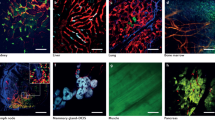Abstract
Intravital microscopy allows a direct visualization of cells’ behavior in their environment in a living organism with all its complexity. With appropriated models, longitudinal studies of structural and functional changes can be followed in the same animal on long period. In the field of cancer, the dorsal window chamber model is the model of choice for tumor events such as cells migration, vessels growth, and their permeability or interactions between cells and vessels. Coupled with wide-field, confocal, or multiphoton fluorescence microscopes, high spatial and temporal resolutions of the cellular events can be analyzed in vivo.
Access this chapter
Tax calculation will be finalised at checkout
Purchases are for personal use only
Similar content being viewed by others
References
Ellenbroek SIJ, van Rheenen J (2014) Imaging hallmarks of cancer in living mice. Nat Rev Cancer 14:406–418. https://doi.org/10.1038/nrc3742
Makale M (2007) Intravital imaging and cell invasion. Methods Enzymol 426:375–401. https://doi.org/10.1016/S0076-6879(07)26016-1
Jain RK, Munn LL, Fukumura D (2002) Dissecting tumour pathophysiology using intravital microscopy. Nat Rev Cancer 2:266–276. https://doi.org/10.1038/nrc778
Makale M (2008) Chapter 8. Noninvasive imaging of blood vessels. Methods Enzymol 444:175–199. https://doi.org/10.1016/S0076-6879(08)02808-5
Beerling E, Ritsma L, Vrisekoop N et al (2011) Intravital microscopy: new insights into metastasis of tumors. J Cell Sci 124:299–310. https://doi.org/10.1242/jcs.072728
Gui P, Ben-Neji M, Belozertseva E et al (2018) The protease-dependent mesenchymal migration of tumor-associated macrophages as a target in cancer immunotherapy. Cancer Immunol Res 6:1337–1351. https://doi.org/10.1158/2326-6066.CIR-17-0746
Asrir A, Tardiveau C, Coudert J et al (2022) Tumor-associated high endothelial venules mediate lymphocyte entry into tumors and predict response to PD-1 plus CTLA-4 combination immunotherapy. Cancer Cell 40:318–334.e9. https://doi.org/10.1016/j.ccell.2022.01.002
Markelc B, Bellard E, Sersa G et al (2018) Increased permeability of blood vessels after reversible electroporation is facilitated by alterations in endothelial cell-to-cell junctions. J Control Release 276:30–41. https://doi.org/10.1016/j.jconrel.2018.02.032
Bellard E, Markelc B, Pelofy S et al (2012) Intravital microscopy at the single vessel level brings new insights of vascular modification mechanisms induced by electropermeabilization. J Control Release 163:396–403. https://doi.org/10.1016/j.jconrel.2012.09.010
Carrière V, Colisson R, Jiguet-Jiglaire C et al (2005) Cancer cells regulate lymphocyte recruitment and leukocyte-endothelium interactions in the tumor-draining lymph node. Cancer Res 65:11639–11648. https://doi.org/10.1158/0008-5472.CAN-05-1190
Acknowledgments
We thank Dr. Philippe Guy and Dr. Véronique LeCabec for the acquisition of the pictures of Fig. 3, Dr. Sophie Chabot for Fig. 4, Dr. Sandrine Pelofy for Fig. 5, and Dr. Bostjan Markelc for Fig. 6. We acknowledge the IPBS Genotoul core facilities, ANEXPLO and TRI, member of the national infrastructure France-BioImaging supported by the French National Research Agency (ANR-10-INBS-04).
Author information
Authors and Affiliations
Corresponding author
Editor information
Editors and Affiliations
Rights and permissions
Copyright information
© 2024 The Author(s), under exclusive license to Springer Science+Business Media, LLC, part of Springer Nature
About this protocol
Cite this protocol
Bellard, E., Golzio, M. (2024). Cancer Imaging by Intravital Microscopy: The Dorsal Window Chamber Model. In: Čemažar, M., Jesenko, T., Lampreht Tratar, U. (eds) Mouse Models of Cancer. Methods in Molecular Biology, vol 2773. Humana, New York, NY. https://doi.org/10.1007/978-1-0716-3714-2_12
Download citation
DOI: https://doi.org/10.1007/978-1-0716-3714-2_12
Published:
Publisher Name: Humana, New York, NY
Print ISBN: 978-1-0716-3713-5
Online ISBN: 978-1-0716-3714-2
eBook Packages: Springer Protocols




